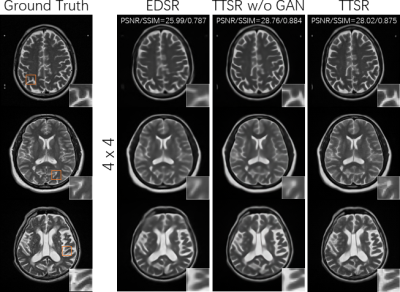Mengye Lyu1, Guoxiong Deng1, Yali Zheng1, Yilong Liu2,3, and Ed X. Wu2,3
1College of Health Science and Environmental Engineering, Shenzhen Technology University, Shenzhen, China, 2Laboratory of Biomedical Imaging and Signal Processing, The University of Hong Kong, Hong Kong, China, 3Department of Electrical and Electronic Engineering, The University of Hong Kong, Hong Kong, China
1College of Health Science and Environmental Engineering, Shenzhen Technology University, Shenzhen, China, 2Laboratory of Biomedical Imaging and Signal Processing, The University of Hong Kong, Hong Kong, China, 3Department of Electrical and Electronic Engineering, The University of Hong Kong, Hong Kong, China
Transformer based neural networks enable high-quality
MRI super-resolution with reference images searched from a large external database

Figure 4. TTSR trained without adversarial
loss could lead to higher PSNR and SSIM, yet was visually more blurred than
standard TTSR with adversarial loss. Nevertheless, TTSR trained without
adversarial loss still resulted in sharper images than the EDSR.

Figure 1. Schematic illustration of the developed
method. The input low-resolution image is first used to find a similar high-resolution
reference in the database, then the low-resolution image and its high-resolution
reference are together input to the transformer based neural network, which
internally extracts their texture features, fuses the features with attention, and
generates high-resolution output images. Note that the reference image search
is done by comparing the distance of GIST features, and thus is extremely fast
(<1s per thousand images)